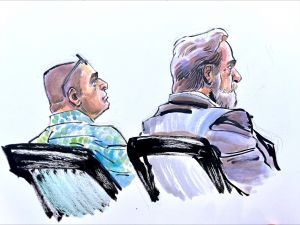DNA, DNA, DNA – Delphi Trial Day Nine

Source: Li Buszka / Sketch Artist
DELPHI, Ind. — DNA evidence was the main focus of the first half of testimony Monday in the Delphi murders trial.
Stacy Bozinovski, forensic scientist and DNA analyst with the Indiana State Police Lab, testified that she went through all of the swabs and fibers tested following the 2017 murders of Abigail Williams and Liberty German.
Hairs found around the fingers of Williams belong to Liberty’s older sister Kelsi, confirmed Bozinovski. She also testified that male DNA was found on some swabs, but she clarified that finding male DNA on some of the areas swabbed was “not necessarily an unusual result.”
Swabs also indicated possible semen, but no semen was officially detected.
DNA testing on the cartridge was “insufficient for further analysis”, and Bozinovski testified that DNA can be hard to pull from cartridges because they’re so small.
Partial profiles were found, but there wasn’t enough to develop a profile.
An unknown male did alert investigators, but it turned out to be a lab employee. Lab employees had to be reminded to wear protective equipment.
Three hairs collected were not consistent with Abby and Libby, Bozinovski testified. She stated there are tests that could analyze hairs without a root, but the lab was afraid of destroying the samples, so they did not move forward with testing. Bozinovski said hair tests of this nature also yielded low success rates.
Through all of this testimony, there was not one link between suspect Richard Allen and the crime scene.
When asked directly if Allen’s DNA was found, Bozinovski said no.
Further explanation of the DNA process, per our news-gathering partners at WISH-TV:
Bozinovski told the jury how difficult it was to get swabs and recover DNA from the creek and says the challenge of testing hair was that it needs to have a skin tag at the root and that natural shedding doesn’t have much of a possibility for DNA testing.
She told the jury she did send a sample of human hair to the FBI that consisted of 72 hairs. The FBI told Bozinovski that 3 of the hairs were “not consistent” with Libby or Abby. She told the jury she chose not to test using “rootless” hair testing as there was not enough hairs to even send and there was a low success rate for the testing.
Bozinovski tells the jury that a momentary moment of touch does not necessarily mean there is touch DNA, that touching evidence is more limited contact, while handling evidence leads to more contact. She says blood is always going to be a better source of DNA than touch DNA.
Pat Cicero takes the stand, per WISH-TV.
Pat Cicero, a LaPorte County sheriff’s major with CSI experience, returned to the stand. State prosecutor James Luttrell began by questioning Cicero about his conclusions about the crime scene and specific details about the bodies.
Cicero told the jury he believed Abby Williams was killed while wearing the clothes she was found in, and said he wasn’t surprised that investigators didn’t predation on the bodies given the climate and temperature on Feb. 13, 2017. He added that he believed at least one person killed the girls, but couldn’t rule out that more may have been involved.
Defense attorney Jennifer Auger asked Cicero about his conclusions on blood found at the scene, asking him to explain how the blood could have transferred to where it did. Auger asked if the girls could have been lifted, and Cicero said “not necessarily,” including that “her body could have been turned.” He mentioned in earlier testimony that Libby’s body may have been moved, or dragged, after her death.
He confirmed to the court, though, that at some point, Libby German’s neck was above her head. Auger noted that it would have been “highly appropriate” to document any drag marks found at the scene in February 2017.
Auger asked Cicero if in all of the photographic evidence he reviewed, could anything link Richard Allen to the murders of Libby and Abby.
Cicero said no.
Luttrell redirected, to which Cicero explained his theory that Libby’s arm could have been used to pull her body, and that if she was dragged, her head would fall back.
Luttrell then asked if sexual assault could occur without leaving DNA and if Libby’s injuries were inflicted at the same time. Cicero said yes to the first question, and said the injuries would have been inflicted at different times.
Auger jumped in, remarking that Cicero “had no idea how that (blood) transfer got on that tree.”
“No,” Cicero said. “Could there have been other methods? Yes.”
“You can’t rule out that Abby and Libby were killed at the same time?” Auger asked.
“No, I can’t,” Cicero concluded.



